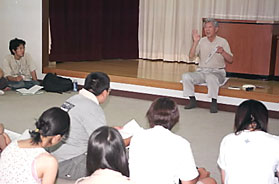
On the 5th, Gensuikyo's (Japan Council Against Atomic and Hydrogen Bombs) 2004 world gathering in Hiroshima broke into section meetings in different venues in Hiroshima to take up the Iraq War, U.S. military bases in Japan, and other problems.
One such section meeting, called "Youth Plaza," carried out the novel plan of dispatching its roughly 400 participants, mostly youths in their 20s, to 11 places in the city to visit hibakusha. At Kogominami Hall in Nishi-ku, area resident Ryuichi Toki (79) told the story of his exposure riding a streetcar in Hiroshima roughly 1.5 kilometers from the hypocenter.
Participants took notes as Toki described how the glass shards piercing his skin drenched him in blood from and made him think, "I am done for." They asked questions such as, "What do you think of the U.S. for dropping the atomic bomb?"
At the Iraq War section meeting, photojournalist Soichiro Koriyama, who was taken hostage by an Iraqi insurgent group, said, "We were spared because we did not have weapons."
The 59th memorial world meeting of Gensuikin in Hiroshima (Japan Congress Against Atomic and Hydrogen Bombs) also held section meetings in Hiroshima at which participants exchanged views on the Japanese government's role in hibakusha assistance and nuclear abolition.
Roughly 100 persons attending the section meeting on the issue of assistance to hibakusha. Regarding the pending class suit filed by 146 claimants in 11 district courts around Japan seeking recognition of their A-bomb diseases, representative Kazuyuki Tamura of the assistance group in Hiroshima asked for support, saying, "The claimants mean to bring to light the cruelty of the atomic bombing through the court system. We are also struggling to move toward the abolition of nuclear weapons and the prevention of nuclear war."
-Rengo and Kakkin meetings demand clear nuclear abolition plan
On the 5th, Rengo (Japanese Trade Union Confederation) opened its 2004 Peace Hiroshima Gathering in Kosei Nenkin Hall in Naka-ku, Hiroshima, adopting a Peace Appeal that included hopes for nuclear abolition and world peace.
The appeal emphasized the necessity of setting a clear schedule for working for nuclear abolition next year, which is the 60th anniversary of the atomic bombing and the year of the NPT (Nuclear Non-Proliferation Treaty) Review Conference. It states the importance of taking the voices of the people in the A-bombed country to the world.
Roughly 2,000 union members attended the gathering. Rengo leader Kiyoshi Sasamori said, "The danger of nuclear war is not past. Let's not give up, but continue to send out our calls for peace."
The Hiroshima meeting of Kakkin (National Council for Peace and Against Nuclear Weapons) was also held on the 5th in a hotel in Minami-ku, Hiroshima City. Roughly 150 persons participated, mainly from the prefecture and western Japan, . President Norihiko Akamatsu of Hiroshima Kakkin said, "The danger of a terrorist incident involving a nuclear explosion is mounting. Let us continue to act to abolish all nuclear weapons as soon as possible." The gathering adopted an appeal that included "inducing the nuclear weapon states to clarify their programs for nuclear abolition."
(Caption)A-bomb survivor Ryuichi Toki tells what happened that day to listeners in their 20's.
    
|